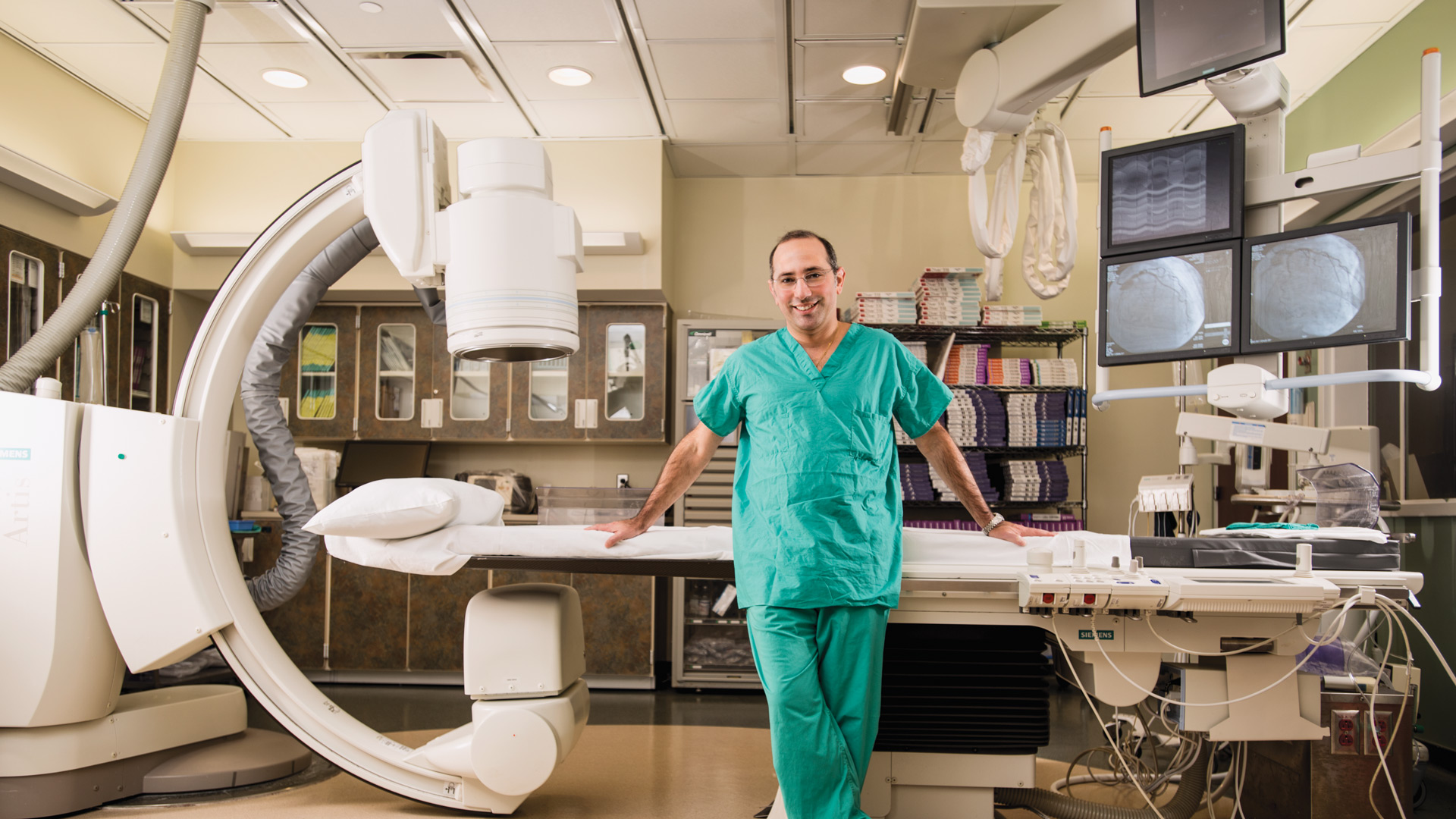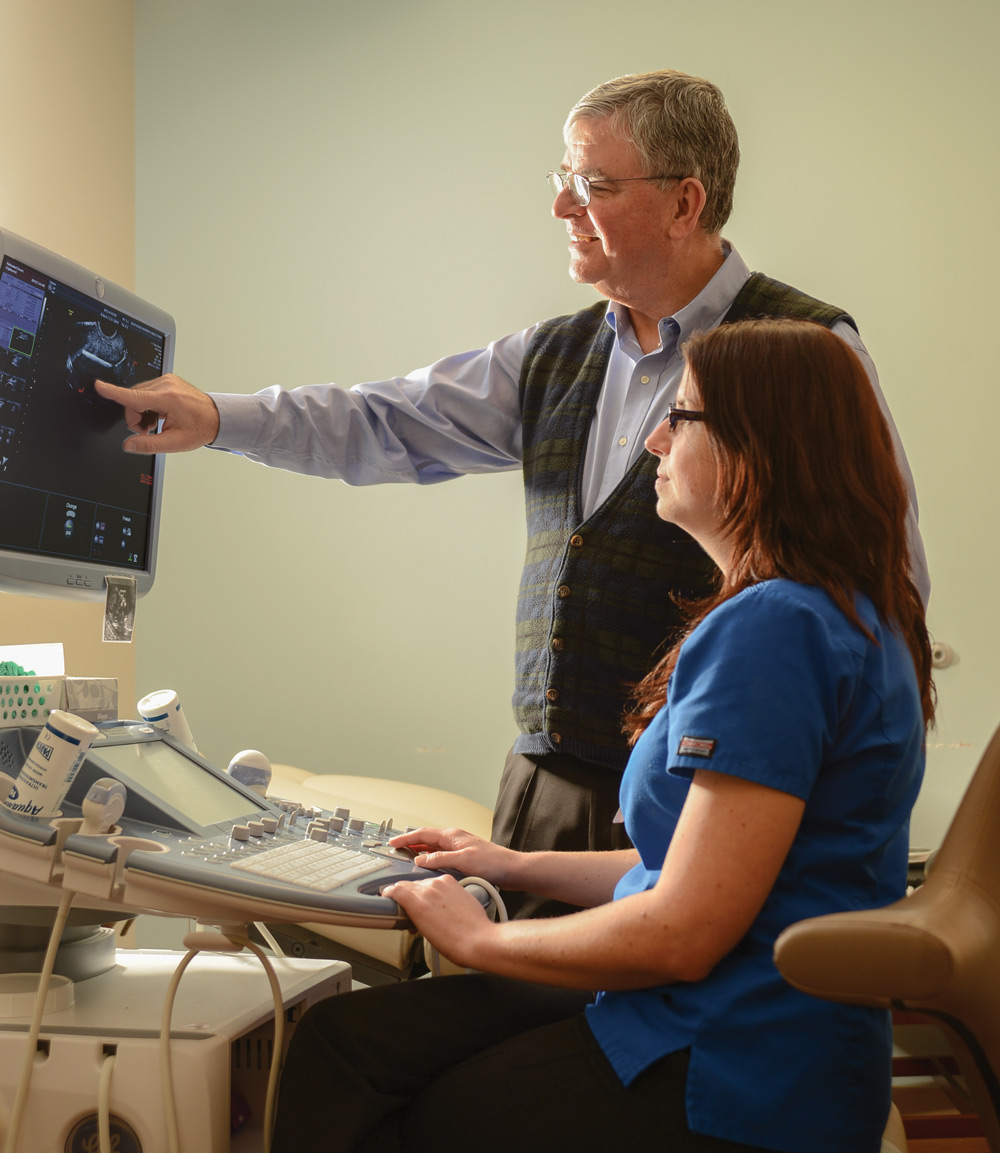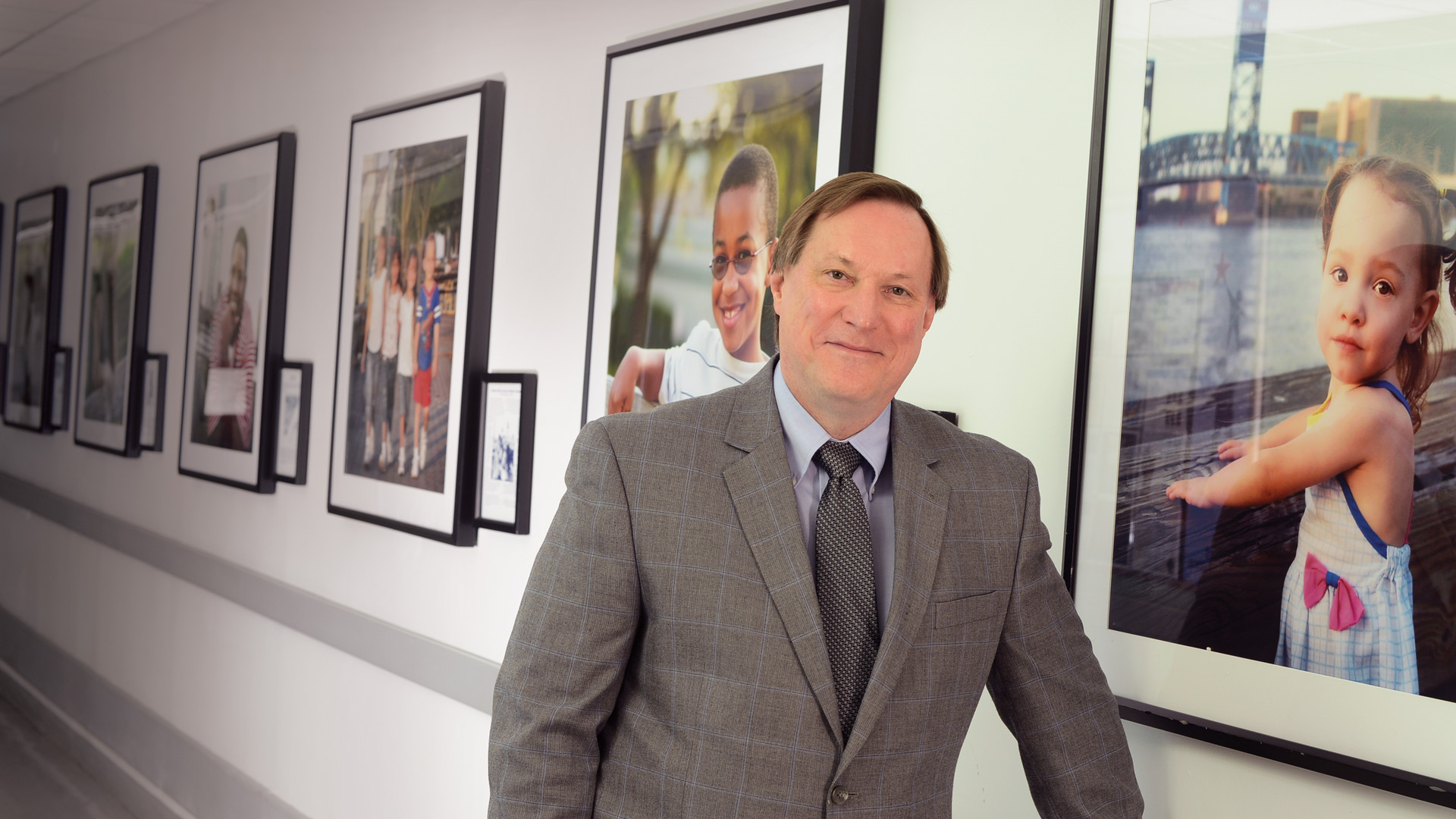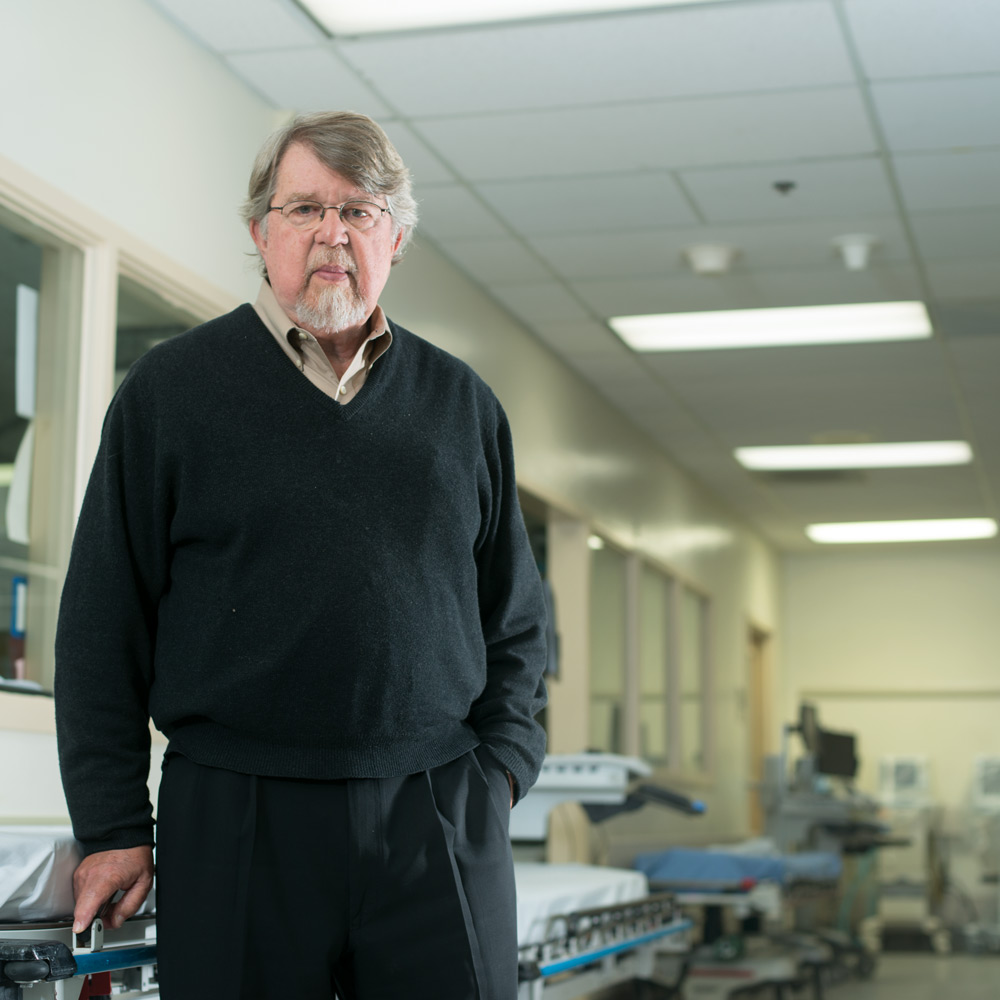In the basement of the emergency medicine corridor of UF Health Jacksonville, Robert Wears, a professor in the Department of Emergency Medicine, scans engineering books and medical journals, carefully piecing together the historical puzzle of hospital safety.
Bridging the fields of engineering, psychology, medicine and sociology, Wears hopes to devise an interdisciplinary plan to minimize harm in health facilities.
“The way that nature has divided up her problems is not the same way the university has divided up its subjects,” Wears says. “You need a really interdisciplinary group.”
Wears is one of many UF researchers based in the heart of Jacksonville. Located less than two hours from the main campus in Gainesville, UF Health Jacksonville has historically been known more for the clinical care it provides patients. But the research occurring at the UF College of Medicine — Jacksonville is internationally recognized. Medical doctors and scientists from around the globe collaborate regularly on groundbreaking research to improve public health and medicine. In fact, during the past five years, federal funding for research on the Jacksonville campus has grown 110 percent.
On the research side, the smaller campus in the big city has excelled in conducting clinical trials utilizing its urban population.
But recently, UF Health has worked to strengthen the support system for those who want to focus on basic and translational research. The Center for Health Equity and Quality Research, or CHEQR, directed by David Wood, a professor of pediatrics, was founded to be a one-stop shop for researchers looking to turn grant proposals into funded studies.
Tina Bottini, an assistant dean in the College of Medicine — Jacksonville Office of Research Affairs, says this new approach includes hiring researchers with doctorates to work with clinicians. Because clinicians have a heavy patient load as their first priority, research in Jacksonville won’t grow without scientists dedicated to research working on the campus, she says.
“It’s a different mindset. The Ph.D.-trained researchers are the ones who are really driving the research,” Bottini says, because they can devote 100 percent of their time to collecting and analyzing data.
The center began as a partnership between the campus and the Duval County Health Department to conduct research that would aid in eliminating health disparities.
“We have a clinical population that suffers from huge health disparities,” says William Livingood, the senior research scientist at CHEQR. “It’s a natural area of research for public health and for health care.”
Among the newly funded projects that began in the center is a study looking at how children with progressive diseases, such as diabetes and muscular dystrophy, transition into adult health care. Another is looking at how to best use social media to educate youth about childhood obesity.
The center also aids in matching people from different fields who have similar interests. For example, Sarah Osian, a medical doctor in the Department of Emergency Medicine, is teaming up with a psychologist to look at breast cancer disparities in north Florida.
Bottini says the new approach is working, and with at least five new doctoral researchers hired in the last year, she has seen a major increase in the number of research proposals.
With a clinical population of more than 1 million people and a 600-bed teaching facility, Daniel R. Wilson, dean of the College of Medicine — Jacksonville, believes the research capacity of the Jacksonville campus will continue to grow.
“There’s a very broad consensus that Jacksonville has the opportunity to develop quite a bit more in the area of bioscientific research and that the University of Florida can and has to be one of the main drivers of that over the next 10 years,” he says.
Cardio Care
Dominick Angiolillo, medical director of the cardiovascular research program at UF College of Medicine — Jacksonville, has one of the largest research programs on the Jacksonville campus.
The program is divided into clinical and translational areas, and Angiolillo says that having postdoctoral clinical and research fellows — with training as medical doctors, Ph.D.s and Doctors of Pharmacy, was crucial in building a comprehensive research program.
The bulk of Angiolillo’s research revolves around treating cardiovascular disease. For years, research on the Jacksonville campus has been ahead of the game in testing new drugs and devices to better aid at-risk heart patients.

UF Health Jacksonville was one of the first sites in the country to clinically test drug-eluting stents, which have now become the standard of care for treating patients with blockages in the arteries of the heart.
Stents are mesh tubes that are used to widen narrow and diseased arteries, and the new ones pioneered by Angiolillo’s team, known as “bioabsorbable stents,” are absorbed entirely over time after implantation in the patients’ blood vessels. The old stents were metallic and would leave metal in the heart.
“Devices for coronary interventions are something our institution pioneered under Dr. Theodore Bass,” Angiolillo says. “Having access to new technologies before they are commercially available really sets us ahead of the curve in the treatment opportunities that we can provide to our patients.”
Along with stents, heart disease patients also are given different types of antiplatelet drugs, which prevent blood clots to the heart.
“These drugs prevent the platelets, the essential component of clots in the arteries, from sticking together and causing heart attacks,” says Jung Cho, a courtesy postdoctoral associate in Angiolillo’s lab.
Angiolillo says Jacksonville’s diverse population and the college’s research facility have helped him pursue his medical goals.
“It’s a privilege for me to work in such a nurturing environment surrounded by great colleagues, great professionals and a support staff, in addition to serving a patient population that is definitely in need of advanced research,” Angiolillo says.
Ladies First
At the Emerson Medical Plaza about 15 minutes away from UF Health Jacksonville, Andrew Kaunitz regularly fields media requests from popular women’s magazines such as Self and Women’s Health. Reporters are always inquiring about Kaunitz’s pioneering research on women’s sexual health.
Kaunitz is testing a drug that has the possibility of treating a problem most women are discreet about: female orgasmic disorder. The drug is a nasal spray and could be thought of as “Viagra for women,” he says.
Kaunitz’s research also contributed to the Food and Drug Administration’s approval of Mirena, an intrauterine device to treat heavy menstrual bleeding. Previously, the IUD was only approved for use as birth control.
“That ends up being very important for our patients because with Mirena, it means that women with this common debilitating problem of heavy menstrual bleeding have a medical option, something we can use right here in the office that allows many women to avoid surgery such as hysterectomy,” Kaunitz says. “A lot of my patients would like to avoid gynecological surgery if they can.”
Kaunitz’s lab is also serving as the lead clinical site for an investigative study testing a second-generation birth control patch with a lower dose of estrogen. The first generation of birth control patches contained high estrogen doses that put women at greater risk of side effects, such as blood clots, he says.
Andrew Kaunitz regularly fields media requests from popular women’s magazines such as Self and Woman’s Health. Reporters are always inquiring about Kaunitz’s pioneering research on women’s sexual health.
Preemie Problems
As a researcher, Mark Hudak is dedicated to improving the lives of premature babies. Because these infants are born so early, they are susceptible to lung and breathing problems, which could result in more serious diseases later on in life.
One of Hudak’s studies is looking at whether giving surfactant, a liquid the lungs make to assist breathing, will help prevent serious breathing problems that are common in preterm babies.
“The only time you’re aware that you’re trying to breathe is when you’re running fast,” explains Hudak, chair of the College of Medicine — Jacksonville’s Department of Pediatrics. “Normal everyday breathing is very easy and that is because of surfactant.”
Many preterm babies are not developed enough to produce surfactant, so Hudak is experimenting with a surfactant treatment to help them breathe.
As part of a study funded by the National Institutes of Health, Hudak is testing whether giving surfactant not only at birth but also at a later age could help stave off breathing problems in kids.
But premature babies are not Hudak’s sole focus.
He and his fellow neonatologists are seeing an increasing number of newborns suffering withdrawal from opioids, many from prescription painkillers. When mothers use illicit drugs or prescriptions such as hydrocodone during pregnancy, their babies will often be born with a condition called neonatal abstinence syndrome. These babies display a constellation of symptoms, such as hyperirritability, tremors, sleep disturbances, fever, vomiting and sometimes even seizures.
“These babies appear to be miserable,” Hudak says. “This is a huge problem. It can happen if a mother is on street drugs like heroin. Or it can happen if she is on a prescription opioid. The babies can have pretty dramatic signs of withdrawal only a day or two after birth.”
Babies suffering withdrawal are treated with small amounts of an oral opioid, then slowly weaned. But Hudak says that weaning may take weeks, extending their hospital stay. He believes there is a more efficient treatment process.
“We think there are improvements that can be made,” Hudak says, such as identifying optimal drugs that would lead to shorter hospital stays.
Hudak is also involved in the NIH-funded National Children’s Study, in which children and their mothers are followed from birth to age 21. The purpose of the study is to collect medical and environmental data to generate hypotheses about the origins of childhood diseases such as diabetes, autism and asthma.
Hudak says the most rewarding part of his job “comes from being able to build clinical and research programs, engage in the exploration of questions, contribute to the fund of knowledge and make a contribution to changing practice in a way that achieves better outcomes for the kids we take care of.”
Patient Safety
While College of Medicine — Jacksonville faculty members conduct most of the research at the Jacksonville campus, Wears believes the future of health care includes collaboration between fields.
Wears, who is also certified in the area of human factors engineering, focuses his research on patient safety. He says that getting engineers and social scientists to work together with medical professionals in designing devices, workflow and record-keeping procedures will optimize the way a hospital operates while lowering patient risk.
Wears is working on a project he describes as the social history of patient safety. His preliminary results show that for the past few decades patient safety has focused on problems doctors are most comfortable with — such as infection.
“Infections aren’t as threatening to doctors,” Wears says. “So as doctors gained control of the patient safety movement it was quite natural for them to focus on infection control. The patient safety movement has gradually migrated toward a set of subjects that doctors are more comfortable with and away from subjects that they’re less comfortable with.”
Getting other professions involved in patient safety research could help address problems that doctors may not understand completely, he says.
The goal of the social history project is to influence policy in a way that requires partnerships between physicians, social scientists, engineers and psychologists to improve patient safety.
Wears explains that if engineers worked alongside medical professionals, the designs of the devices and machinery used in saving lives could be improved to prevent errors.
I would like to see safety centers developed with a mixing bowl of skills all in one place, not tied to a short-term project, but a bit more permanently engaged so they could produce some basic research about how people make sense of the world,” Wears says.
Sources:
- Dominick Angiolillo, Associate Professor, Department of Medicine, (904) 244-3933
- Mark Hudak, Professor, Department of Pediatrics, (904) 244-3056
- Andrew Kaunitz, Professor, Department of Obstetrics and Gynecology, (904) 244-3109
- Robert Wears, Professor, Department of Emergency Medicine, (904) 244-4405
Related Website:
This article was originally featured in the Spring 2014 issue of Explore Magazine.




